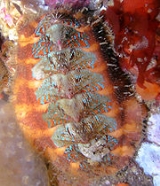
Mopalia spectabilis
Encyclopedia
Mopalia spectabilis, commonly known as the Red-flecked Mopalia, is a species of chiton
.
and Tonicella undocaerulea
both have wavey bright blue lines on valves, however both Tonicella
species have hairless girdles that are red or pink, often with yellow or white mottling, but never brown bands.
, Alaska
to Baja California
. It is commonly found under ledges and on the bottoms of rocks in intertidal waters to a depth of 10 m (33 feet).
s including sponges, hydroid
s, bryozoans, and tunicate
s (particularly Metandrocarpa taylori). A species of scaleworm is sometimes found in the mantle cavity. This species often carries hitchhikers attached to its valves, including encrusting bryozoans and small tube worm
s. Recent molecular systematic studies have suggested that M. spectabilis is not a monophyletic
species, with Mopalia ferreirai nested within M. spectabilis.
Chiton
Chitons are small to large, primitive marine molluscs in the class Polyplacophora.There are 900 to 1,000 extant species of chitons in the class, which was formerly known as Amphineura....
.
Size and description
M. spectabilis is a chiton that has a central area of plates 2-7 pitted in longitudinal rows. The girdle commonly banded light orange and brown. This species nearly always exhibits bright turquoise zigzag markings. The girdle bears prominent hairs that are plumed and are said to look like small “bottle brushes”.Similar species
Tonicella lineataTonicella lineata
Tonicella lineata, commonly known as the lined chiton, is a species of chiton.-Size and description:T. lineata is a very colorful chiton, having blue, purple or black straight or zig-zag lines on each of the eight valves. The background color of the valves is often brown or red, but can also be...
and Tonicella undocaerulea
Tonicella undocaerulea
Tonicella undocaerulea, commonly known as the Blue Lined Chiton, is a species of chiton.-Size and description:The Blue Lined Chiton has a head plate with zigzag white concentric lines without a dark border. It commonly has bright electric blue stripes and flecks when alive...
both have wavey bright blue lines on valves, however both Tonicella
Tonicella
Tonicella is a genus of chitons known as the lined chitons. The genus name derives from the Greek tonos and cell .-Species:Species within the genus Tonicella include:...
species have hairless girdles that are red or pink, often with yellow or white mottling, but never brown bands.
Distribution and habitat
The natural range of M. spectabilis stretches from Kodiak IslandKodiak Island
Kodiak Island is a large island on the south coast of the U.S. state of Alaska, separated from the Alaska mainland by the Shelikof Strait. The largest island in the Kodiak Archipelago, Kodiak Island is the second largest island in the United States and the 80th largest island in the world, with an...
, Alaska
Alaska
Alaska is the largest state in the United States by area. It is situated in the northwest extremity of the North American continent, with Canada to the east, the Arctic Ocean to the north, and the Pacific Ocean to the west and south, with Russia further west across the Bering Strait...
to Baja California
Baja California
Baja California officially Estado Libre y Soberano de Baja California is one of the 31 states which, with the Federal District, comprise the 32 Federal Entities of Mexico. It is both the northernmost and westernmost state of Mexico. Before becoming a state in 1953, the area was known as the North...
. It is commonly found under ledges and on the bottoms of rocks in intertidal waters to a depth of 10 m (33 feet).
Biology
This chiton feeds on a variety of invertebrateInvertebrate
An invertebrate is an animal without a backbone. The group includes 97% of all animal species – all animals except those in the chordate subphylum Vertebrata .Invertebrates form a paraphyletic group...
s including sponges, hydroid
Hydroid
-Marine biology:Hydroids are a life stage for most animals of class Hydrozoa, small predators related to jellyfish.-Botany:In mosses, hydroids form the innermost layer of the stem of long, colourless, thin walled cells of small diameter.The cells are dead and lack protoplasm.They function as water...
s, bryozoans, and tunicate
Tunicate
Tunicates, also known as urochordates, are members of the subphylum Tunicata, previously known as Urochordata, a group of underwater saclike filter feeders with incurrent and excurrent siphons that is classified within the phylum Chordata. While most tunicates live on the ocean floor, others such...
s (particularly Metandrocarpa taylori). A species of scaleworm is sometimes found in the mantle cavity. This species often carries hitchhikers attached to its valves, including encrusting bryozoans and small tube worm
Tube worm
A tube worm is a worm-like sessile invertebrate that anchors its tail to an underwater surface and secretes around its body a mineral tube, into which it can withdraw its entire body.Tube worms are found among the following taxa:...
s. Recent molecular systematic studies have suggested that M. spectabilis is not a monophyletic
Monophyly
In common cladistic usage, a monophyletic group is a taxon which forms a clade, meaning that it contains all the descendants of the possibly hypothetical closest common ancestor of the members of the group. The term is synonymous with the uncommon term holophyly...
species, with Mopalia ferreirai nested within M. spectabilis.

